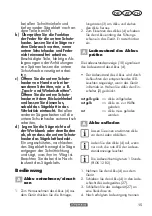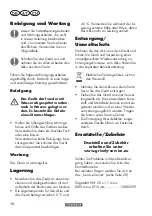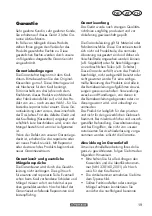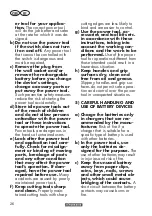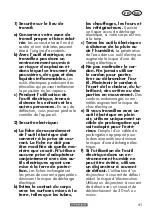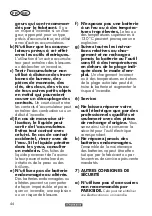
GB
IE
29
a straight edge guide.
This
improves the cutting precision
while minimising the possibility
of the saw blade jamming.
g) Always use the right size saw
blades with the appropriate
locating holes (e.g. diamond or
round).
Saw blades that do not
fit in the saw fitting parts run
unevenly and lead to a loss of
control.
h) Never use damaged or incorrect
saw blade washers or screws.
The saw blade washers
and screws were designed
specifically for your saw to
ensure optimal performance
and dependability.
Further safety instructions
for all saws
SPRING-BACK – CAUSES AND
CORRESPONDING SAFETY
INSTRUCTIONS
•
Spring-back is the sudden
reaction caused by a jammed,
stuck or improperly aligned
saw blade resulting in an out-of-
control saw lifting and moving
out of the workpiece and
towards the operator.
•
If the saw blade snags or gets
caught in the closing sawing
gap or sticks, it will jam, and
the motor force will kick the saw
back towards the operator.
•
If the saw blade is twisted in the
saw cut or incorrectly aligned,
the teeth of the rear edge of
the saw blade can jam in the
wood surface, causing the saw
blade to move out of the sawing
gap and the saw to recoil in the
direction of the operator.
Spring-back is caused by wrongly
or incorrectly operating the saw.
It can be avoided by suitable
precautionary measures, such as
those described below.
a) Hold the saw firmly and bring
your arm into a position in
which you can resist the spring-
back force. Always hold onto
the side of the saw blade and
never align the saw blade with
your body.
In the event of a
spring-back, the circular saw
can kick back, but the operator
can keep control over the
spring-back forces using suitable
precautionary measures.
b) If the saw blade jams or you
interrupt your work, switch
the saw off and keep it still in
the workpiece until the saw
blade has come to a full stop.
Never try to remove the saw
from the workpiece or pull it
back as long as the saw blade
is moving, as otherwise it may
spring back.
Identify and correct
the cause of the saw blade
jamming.
c) If you want to restart a saw
that is in the workpiece, centre
the saw blade in the sawing
gap and check whether the
teeth are jammed in the
workpiece.
If the saw blade
jams, it can move out of the
workpiece or cause spring-back
when the saw is restarted.
d) Support large plates to reduce
the risk of spring-back due to
Содержание 338160 2001
Страница 124: ...124...
Страница 133: ...20200728_rev02_ts 133...

